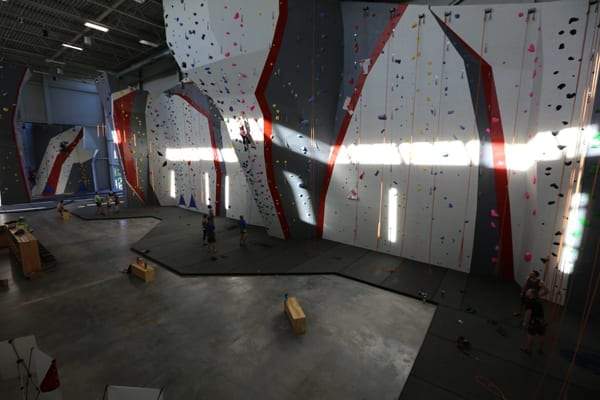Solutions for Top 4 Climbing Wall Questions at NIRSA 2017


1. What’s the difference between flooring for bouldering and roped climbing?
The biggest differences is are depth and softness. Bouldering flooring should be at least 12" thick and is quite squishy. Flooring for roped climbing areas should be up to 5.5" thick and is much firmer. Since no ropes are used as protection for boulderers and boulderers always drop onto the floor, bouldering areas need deeper, softer flooring for fall attenuation. More questions about flooring?

In this above photo of Adventure Rock MKE you can see the 5.5" carpet-bonded foam flooring that is recommended for roped climbing walls. The flooring follows the "drip-line" of the walls plus 6' more. The "drip-line" is the farthest edge of the climbing walls as they lean out from the building wall.
2. How do we make sure our new walls support adaptive climbing programs?
- Incorporate less-than-vertical sections of wall, a.k.a. slabs—Routes that go up slabs are often the first climbs for most climbers. Since the climber can lean slightly forward and put weight fully on a foot or feet, the experience can be much like climbing a ladder. For anyone with balance issues or limited upper body strength or functionality, slab routes are optimal.
- Include slightly more-than-vertical areas of wall, a.k.a. overhangs—Overhangs provide safe terrain for sit climbers who need to campus or jug up a route. Campusing is a technique where the climber just uses their hands to pull up from hold to hold—imagine moving up the underside of a ladder without using your feet. Jugging is a process by which a climber ascends a rope using an auto-locking device. With either style, the climber should not have to drag themselves along the wall.
- Build a corner—Corners are particularly good for setting a groundbreaking, new style of routes for sit climbers. This style allows the climber to rest along the route by sitting on very large holds that are incorporated into the route. Imagine doing a few pull-ups to move up and then sitting on a shelf. You figure out your next set of moves, do a few more pull-ups, then rest again. Repeat until you reach the top of the route. This provides an opportunity for strategy and not just strength.

- Provide enough floor space for wheelchairs, assistance dogs, and extra gear—Many adaptive climbers have a lot of stuff in tow. You need to ensure that there is enough space for what is left on the ground and it is out of the fall zone.
- Choose walls with large, planar surfaces—Creative routesetting is critical for the success of any climbing program, including adaptive. Large, flat areas accommodate giant holds and volumes as well as a high concentration of smaller holds.
- Connect with organizations that support and promote adaptive climbing such as Paradox Sports. They can provide you with training, local resources, and sources for equipment.
More questions about wall for adaptive climbing programs?
3. How do we reduce risk in our climbing areas?
- Join the Climbing Wall Association. This is the best place to learn about climbing wall industry standards, best practices, official certification offerings, and other educational opportunities.
- Train your staff as certified Climbing Wall Instructors. The Climbing Wall Association and American Mountain Guides Association offer courses.
- Install the proper flooring. See #1.
- Train and test your climbers. Staff need to teach boulderers how to properly fall and how to spot other boulderers. Roped climbers need to be taught and tested on how to properly tie-in, communicate with their belayer, and have the skills to top rope or lead climb. Belayers of top-ropers and lead climbers need to pass skills tests.

- Properly staff your climbing space. Staff need to be particularly vigilant when it comes to proper belaying. Belayers can become distracted and a bit sloppy over time. Staff should be ready to intervene.
- Create a culture of awareness and mentorship. If staff lives, breathes and visibly engages in solid safety practices, your climbers should develop similar habits. Risk is greatly reduced when everyone in the climbing space is mindful of rules and best practices and supportive of their fellow climbers.
More questions about reducing risk?
4. Can a racquetball court be converted into climbing terrain?
Certainly. Here are a few details that need to be gathered in order to determine the possible configurations and price.- Can the walls of the court support attached climbing walls? Climbing walls can usually be attached to walls made of CMU/cinder block or to load-bearing/structural studs and beams.
- What is the access like? Can a forklift move from outside the building directly to where the court is located?
- Are there glass/Plexiglas sections that need to be protected and maintained?
- Do you want climbing walls on 1, 2, or 3 sides of the court? Climbing terrain across the ceiling?





Leave a comment